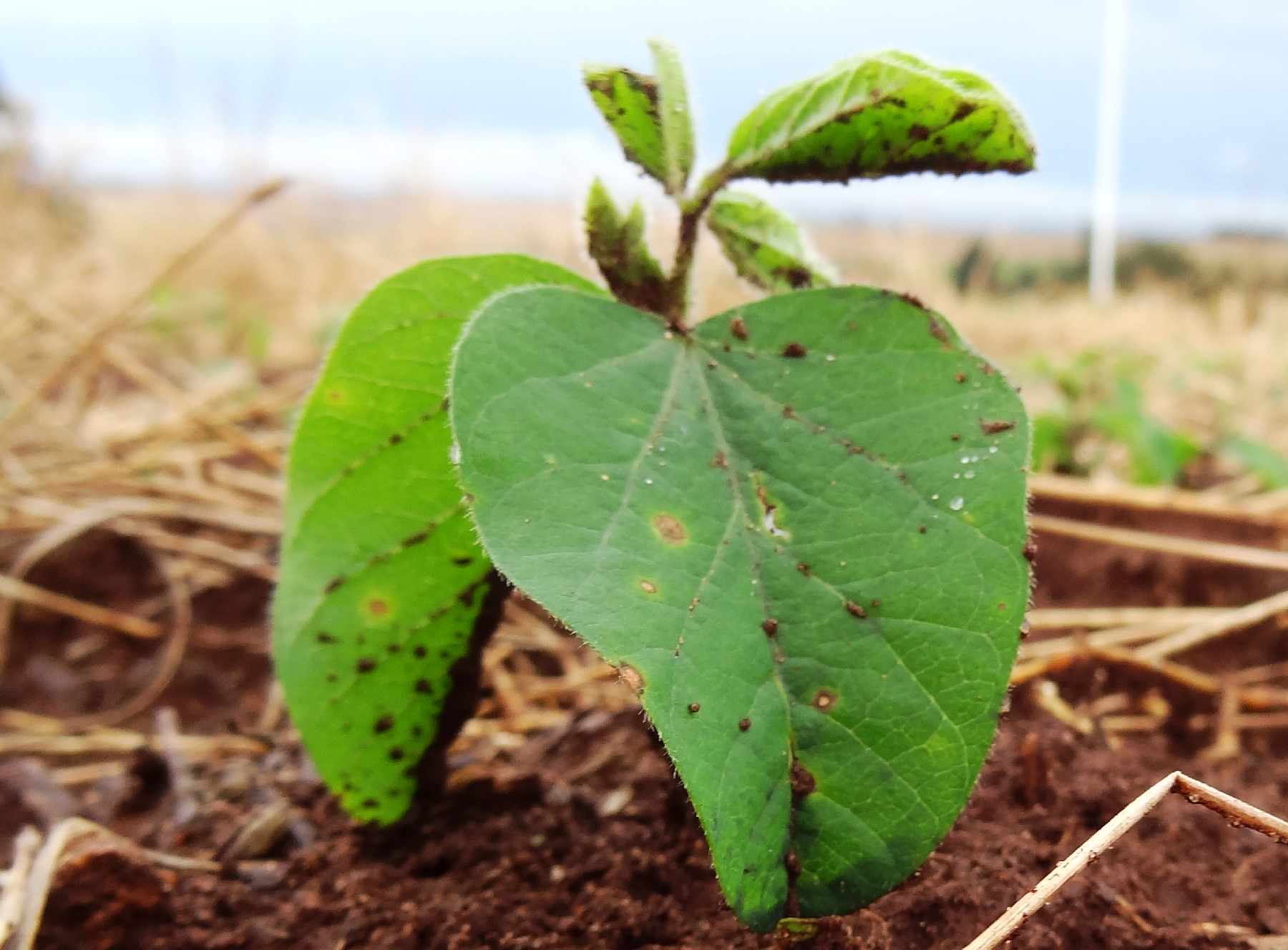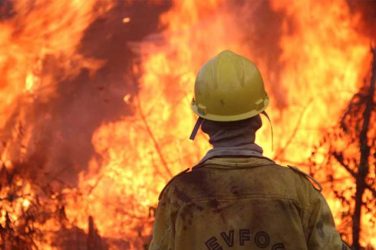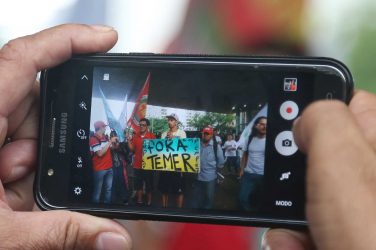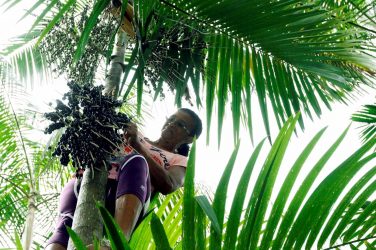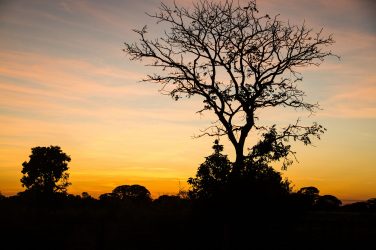At the turn of the 21st century, a juggernaut of expanding soy production moved into the Brazilian rainforest, putting a relentless squeeze on the Amazon. Soy growers arrived from the south, overrunning native forest in Mato Grosso state, then leapfrogged over much of Pará state to the Santarém district, with its flat plateau — ideal for agribusiness.
Brazilian social movements sounded the alarm. They were justifiably worried that soy would destroy rainforest livelihoods, along with the Amazon biome. On May Day, 2004, protesters — acting in unison with labor movement protests across Brazil — held a large demonstration in Santarém at the new grain terminal owned by Cargill, the largest U.S. grain trader.
Joined by international environmental NGO, Greenpeace, the anti-soy offensive became urgent: Amazon deforestation was exploding. In 2003-04, annual Amazon forest loss topped 27,000 square kilometers (10,424 square miles).
In 2006, Greenpeace published a hard-hitting report called “Eating up the Amazon”, showing that soy had become a serious driver of deforestation. The NGO accused fast food restaurants, supermarkets and agribusiness, of a “forest crime” for their failure to responsibly manage the 4,000-mile soy supply chain that started with the clearing of virgin Amazon forest and ended in U.S. poultry, pork, and beef feedlots, and on American and European dinner plates.
The story resonated with the international press. McDonalds, Walmart and other big transnational food corporations sought a way to shine up a tarnished public image. In a hasty attempt at damage control, they contacted the big grain traders, including Cargill and Bunge, and began talks with Greenpeace.
The result: the Amazon Soy Moratorium (ASM), the first major voluntary zero-deforestation agreement achieved in the tropics. In the pact, 90 percent of companies in the Brazilian soy market agreed not to purchase soy grown on land deforested after 2006 within the Amazon biome, and also to blacklist farmers using slave labor.
But even before the moratorium was signed, the annual rate of Amazon deforestation fell dramatically, by almost 80 percent. Still the ASM was touted as being responsible for this remarkable decline, with the Ethical Consumer calling it “an incredible success” and Cargill advertising it as “a resounding success.”
This reported achievement led to multiple renewals, and in 2016 the soy industry agreed to make the ASM permanent. The only major change over time was a shift in baseline, originally fixed at 2006, then moved to 2008 to fit with the government’s controversial new forest code — which environmentalists argued made concessions to those illegally clearing forest.
The question today: has the ASM truly played a key role in stemming Amazon deforestation, and was it ever designed to achieve that result? Or has it largely served as an industry PR tool that distracts global consumers from the environmental and social harm being done by large-scale Brazilian soy plantations?
Measuring the Moratorium
In 2014, scientists decided to thoroughly investigate the ASM’s overall effectiveness. University of Wisconsin-Madison assistant professor of geography Holly Gibbs and her team published their results in the prestigious academic journal Science in January 2015:
In the 2 years preceding the agreement, nearly 30 percent of soy expansion [in the Amazon biome] occurred through deforestation rather than by replacement of pasture or other previously cleared lands. After the Soy [Moratorium], deforestation for soy dramatically decreased, falling to only 1 percent of expansion in the Amazon biome by 2014.
This appears to be an unambiguous vindication of the moratorium. But not necessarily.
The study points out that many farmers in Mato Grosso, who accounted for 85 percent of the soy planted in the Amazon biome, were continuing to clear forest illegally on their land, while claiming compliance with the ASM:
At least 627 soy properties in Mato Grosso violated the FC [Brazil’s forest code] and cleared forest illegally during the Soy [Moratorium]. Yet only 115 properties were excluded by soy traders for Soy [Moratorium] violations. This discrepancy can occur because the Soy [Moratorium] regulates only the portion of the property where soy is grown — not the entire property.
This loophole compromised the effectiveness of the ASM, and puts into question the huge deforestation reductions claimed by soy farmers in the Amazon biome — yet no mention of this shortcoming was ever made in the pro-ASM promotional materials circulated by moratorium advocates.
It is true that Amazon deforestation fell dramatically during most of the moratorium period. So what caused this decline, if not the ASM? A study published by Science in 2014 found that at least three factors accounted for the reduction, with ASM’s impact marginal.
In a Mongabay interview, lead researcher and Earth Innovation institute director Dan Nepstad, cautioned: “It is impossible to quantify exactly the effect of the moratorium on deforestation. I think it was responsible for 5-10 percent of the total decline.”
Two other factors had bigger impacts, his team found. By 2004, so much Amazon forest had been cleared that there was plenty of land for agribusiness expansion, and using this already cleared land didn’t violate the ASM. The second factor related to “improvements in livestock yields, which had further reduced the demand for new land to be cleared.”
In evaluating the overall effectiveness of the ASM, it is very important to look at exactly what it achieved. Gibbs’ team was extremely careful in its 2015 study’s conclusion, saying that: “deforestation for soy dramatically decreased.”
NGOs and some in the press were not so meticulous. Greenpeace, for example, claimed that the moratorium represented “a huge step towards halting Amazon deforestation”.
This statement is not accurate: what the moratorium set out to do and largely achieved, was to stop Amazon forest being directly cleared to plant soy. However, this is very different from halting deforestation in the Amazon.
Gaming the Moratorium
There were other ways, apart from the one described in the Gibbs study, by which farmers got around the ASM.
When, for example, soy growers move onto pasturelands cleared before 2008, they are in full compliance with the ASM. But the cattle displaced by that move now require new pasture, which may be secured by Amazon land thieves who drive out indigenous and traditional people, slash and burn the rainforest, then sell the new pasture to ranchers.
“Very often the cultivation of soy moves to areas where cattle are reared and the cattle move into the forest”, explained Bernardo Machado Pires, who manages environmental issues for the Brazilian Association of the Vegetable Oil Industries (ABIOVE). He went on: “The soy industry is indirectly responsible”.
Research conducted in 2006 by Dan Nepstad reached a similar conclusion: “In my interviews with farmers in Mato Grosso several spoke about the way cattle producers (and land thieves) get capital by selling their land to soy farmers.”
Greenpeace was aware of this cattle loophole, and helped negotiate a deal with Brazil’s three largest meatpacking firms who agreed not to purchase cattle reared on Amazon forest lands illegally cleared after 2008. But, it seems, the agreement is often infringed.
When we were in the district of Castelo de Sonhos in 2014, employees from Brazil’s largest meat-packing company, JBS, told us that the meatpacking firms themselves had found ways of getting round the deal.
The most widespread, they said, is “cattle laundering” by which cattle owners move cattle that were reared on illegally cleared land to established pastures, just before they are slaughtered.
Large-scale soy production indirectly drives Amazon deforestation in yet another way: new and improved roads, such as highway BR-163, lobbied for by soy growers, and built primarily to move soy from Brazil’s interior to market, give large numbers of illegal loggers, land grabbers and ranchers access to the Amazon’s heart.
Commodities companies Cargill, Bunge and Amaggi (Brazil’s largest soy producer) are also committed to a massive soy transportation infrastructure expansion that would pierce the heart of the Brazilian Amazon, helping deforest a region known as the Tapajós basin, bringing new roadways, railways, and an industrial waterway, along with 40+ major dams.
Focusing on One Biome
With so much media attention concentrated on the ASM, another serious problem — that of the destruction of the Cerrado, Brazil’s biodiverse savanna — has been neglected. Legal Amazonia (as demarcated by the Brazilian government) covers two biomes: the Amazon biome and the Cerrado biome. The ASM only covers the former.
And both Legal Amazonia biomes contain plenty of room for the soy industry to expand without violating the letter of the ASM agreement.
“There still are 40.5 million hectares [156,371 square miles] of anthropized land [degraded by human activity] with a high or medium aptitude for soy — with 22 million hectares [84,942 square miles] in Amazonia and 18.5 million hectares [71,428 square miles] in the Cerrado.
It is mainly occupied by pasture and it is to these lands that the government must direct future grain expansion,” said National Institute of Amazonia Research (INPA) scientist Arnaldo Carneiro, whose study looked at the possibilities of commercial agriculture expansion in the region.
Although Carneiro’s work, along with other agribusiness-backed studies, claims this vast acreage as a “sustainable” solution to the industry’s need for new croplands, this doesn’t mean that all of it is readily available to large scale farmers.
Much is currently occupied by a wide variety of groups — including land thieves, cattle ranchers, peasant and traditional communities, and agrarian reform settlements — a fact that could bring a great deal of conflict, especially in the Amazon biome, before the destiny of this land is decided.
Adding to the complexities of deforestation analysis: some of this “available” land will have been cleared after 2008 and, on paper at least, is banned for soy use by the ASM.
This isn’t a problem for agribusiness in the Cerrado: all soy produced there can be marketed with the ASM-accurate, but misleading, claim that it caused “zero deforestation in the productive chain,” even if it was cultivated on recently cleared land.
And unfortunately for Brazil, the world, and wildlife living there, the Cerrado is one of the planet’s richest tropical savanna regions, with high levels of endemism.
But that biodiversity is rapidly vanishing. Researchers recently used satellite data to determine that Cerrado cropland within a 45 million-hectare (173,745 square mile) study area in Matopiba doubled over the past decade, increasing from 1.3 million hectares (5,019 square miles) in 2003 to 2.5 million hectares (9,652 square miles) in 2013.
The researchers also found that almost three-fourths of this agricultural expansion was achieved through the destruction of native Cerrado vegetation.
Experts have seriously questioned the wisdom of placing so much emphasis through the ASM on the damage done exclusively to tropical forests. In 2015, Gibbs called for the Amazon Soy Moratorium to be extended to the Cerrado:
“If large-scale soy expansion continues in Matopiba, remaining natural vegetation could be highly susceptible to soy conversion without additional safeguards. Expanding the Soy [Moratorium] could reduce the on-going direct conversion of Cerrado vegetation to soy.”
But this hasn’t happened yet.
Brazil’s environment minister José Sarney Filho suggested last year that the moratorium be extended to the Cerrado and talks began, said Tica Minami, Greenpeace Brazil’s Amazon Project Leader. But no deal has been struck, largely because the soy industry is reportedly very reluctant to come on board.
Meanwhile, soy expansion continues at full throttle there. Mighty Earth, a global environmental organization, recently sent researchers into the region. They traveled for hundreds of miles in the Cerrado and, to their dismay, always found the same: “Vast areas of savanna recently converted to enormous soybean monocultures that stretch to the horizon.”
Farmers confirmed to Mighty Earth that they are mainly selling to Cargill and Bunge — two leading ASM signatories — with these companies often providing the financial incentives that are fueling the savanna’s transformation.
The Might Earth report urges a moratorium there: “The kind of deforestation we found in the Cerrado… is not inevitable. In the Brazilian Amazon, Cargill, Bunge and other companies have figured out how to protect ecosystems and still grow their businesses.”
But, say critics, the ASM has only worked in the Amazon biome because there was already so much cleared land there, along with the ASM-excluded Cerrado lands, into which soy farmers could expand, without infringing the moratorium.
This allowed the companies to publicize their success in protecting the forest without essentially changing the way they operate. As Cargill helps destroy the Cerrado, the company can use the ASM to cover itself with an aura of green sustainability, stating on its website:
In Brazil, we have seen great progress as we partnered to advance the soy moratorium in the Amazon for more than a decade. Today, we are working with more than 15,000 soy farmers and collaborating with governments, NGOs and partners to implement the Brazilian forest code and advance forest protection.”
So, while the grain companies were helping to destroy the Cerrado, Cargill, together with Greenpeace and McDonalds, were also awarded the Keystone Prize for “leadership in significantly reducing deforestation in 2015. Bunge, Cargill and Amaggi did not respond to requests for comment for this article.
Soy, the Environment and Social Justice
While commodity companies loudly trumpet their success in stemming deforestation, they ignore other soy industry impacts. Pesticide use, for instance, is overlooked in ASM promotional materials, according to Dr. Wanderlei Pignati, a lecturer at the Federal University of Mato Grosso and author of several studies on pesticide health and environmental effects.
He told Mongabay that about 200 million liters (nearly 52 million gallons) of agrochemicals are dumped annually on Mato Grosso crops. These applications can cause “cancer, fetal malformations, endocrine disruptions, neurological diseases, mental disorders, respiratory and intestinal disorders.”
The ASM eclipses other harm done by soy, say Brazil’s social advocates, albeit unintentionally and largely without public notice. The problem: studies that quantify degraded rainforest areas only measure acreage; they don’t take into account traditional communities, or even indigenous lands, unless the latter have been officially demarcated — something Brazil’s government has failed to accomplish in many reserves.
For that reason, indigenous and traditional lands are sometimes classified as places where soy is free to expand under the ASM.
This has led to injustices, say experts. Though the ASM has likely protected Amazon rainforest in the Santarém district — where soy was consuming large blocks of forest between 2003 and 2005 — a high price is being paid by local communities as agribusiness targets their lands.
Many indigenous, peasant and traditional communities carefully clear forested areas, using them for a time, then allowing the land to recover, without destroying biodiversity.
These traditional ways of occupying the land were developed over centuries, and represent highly successful and sustainable methods of agro-forestry management.
However, the forest areas the people leave fallow, and to which they plan to return, are being counted under the ASM as cleared areas, and so are not protected by the moratorium.
Rural worker and union leader Maria Ivete Bastos lives in one such community. She told Mongabay that: “Soybeans took over a large territory of ours, where we cultivated our crops. Little people can’t fight big people, so we had to hand much of our land over. In some cases we sold all of it, just keeping a little plot around the house.”
Ivete complains about pollution from neighboring soy plantations: “The people who lived on the plateau had creeks, and they used the water.… All this water became contaminated because the soy farmers put their products there — the pesticides they use on their plantations.”
Another rural worker, Dona Maria Alba Pinto de Souza, 62, despaired: “All my life now is in the middle of soybeans, soy farmers. They plant their soy, and it’s bad for us, because you can’t even rear animals.”
The soy farmers want her to leave, she said: “They’ve tried three times to buy my plot but I don’t want to sell it.”
Dona Maria believes that if she sells her land, she’ll be left “lying flat on the ground, going hungry, having nothing to eat but bread and coffee. I know many people who sold their land and now live in Santarém, with nothing. They don’t have a job. Their sons live on the edge of society, their daughters end up as prostitutes. If I sell my land, I’ll have to live under a bridge.”
Soy Moratorium or Greenwash?
The underlying conundrum — as shown in earlier articles in this series — is that mechanized soybean production on the gigantic industrial scale pursued in Brazil leads to dramatic wholesale changes in land use and destroys biodiversity. It concentrates land ownership with the wealthy few, while exacerbating social inequality and failing to tackle poverty.
Seen in this light, the ASM addresses a single narrow aspect of soy production — it reduces direct Amazon soy deforestation somewhat, but ignores grave concerns, which, indeed, were never in its brief.
In response, soy moratorium defenders point to the Amazonian deforestation the ASM did prevent, and note that the moratorium became the model for zero deforestation commitments in the global palm oil, pulp and paper, and rubber sectors, as well as helping shape the Brazilian cattle agreement.
True, but evidence collected for this story shows that the model, in fact, promised very little and successfully delivered this very little. At the same time, some ASM advocates made wildly overblown claims, even presenting it as “a game changer for the Amazon,” while distracting global attention away from the very serious problems created by soy, further empowering a sector that is causing widespread environmental and social devastation. This has led some progressive Brazilian analysts to label ASM as little more than propaganda and greenwash.
Even so, other analysts, like Dan Nepstad, believe that ASM benefits outweigh shortcomings, though he worries about the future. His 2014 study warns: “Eventually cleared land that is suitable for soy production — the most profitable use of cleared land — will become scarce. As the scarcity sets in, the 120,000 square kilometers [46,300 square miles] of forests that could be profitably converted to soy in the Brazilian Amazonia, and that lie outside protected areas will become the target of deforestation pressure.”
At that point, the moratorium might make a real difference. But it remains to be seen if agribusiness’s much publicized commitment to the ASM — a voluntary agreement — and to protecting rainforest, will last when it really matters.
Antônio Ioris, professor of human geography at Cardiff University, and author of a book on Mato Grosso agribusiness, believes that up to now the moratorium has made little difference to the way agribusiness conducts itself on the ground: “The moratorium obfuscates the debate,” Ioris told Mongabay.
“I think its main objective is to improve the image of the agribusiness sector and to reduce somewhat the stigma of [soy production] being an activity with highly negative [environmental and social] impacts. Those who have gained most with the moratorium are agribusiness leaders, the ministry of the environment and NGOs. Those who have gained least are the ecosystems and the local populations.”
This article appeared originally in Mongabay – https://news.mongabay.com


